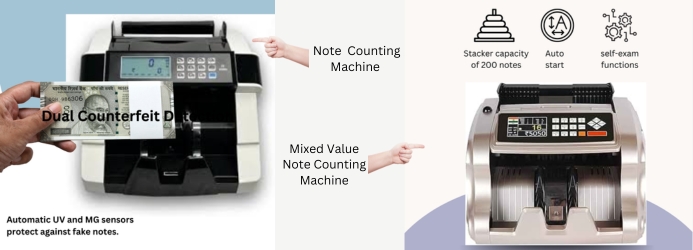When it comes to efficiently managing cash, cash counting machines and mixed value counting machines are essential tools for businesses. While they might look similar, these machines have distinct features tailored to specific needs. Let’s dive into the details to help you choose the right one for your business.
What Is a Cash Counting Machine?
A cash counting machine is designed to count bills of the same denomination. For instance, if you place a stack of $10 bills into the machine, it will tell you the total number of bills in that stack. This makes it a great choice for businesses that mainly handle one type of denomination, such as toll booths, small retail stores, or transportation services.
However, keep in mind that these machines can’t differentiate between mixed denominations. If you mix $10 bills with $20 or $50 bills, the machine won’t distinguish between them—it’ll only provide the total number of bills.
What Is a Mixed Value Counting Machine?
Mixed value counting machines are a more advanced solution. Unlike standard cash counting machines, they can handle bills of different denominations in a single stack. These machines automatically recognize the value of each bill and calculate the total amount.
Mixed value counting machines are particularly useful for businesses that deal with high cash volumes and various denominations, such as:
- Banks
- Retail stores
- Casinos
Key Features of Mixed Value Counting Machines:
- Counterfeit Detection: Identify and separate fake bills, reducing fraud risks.
- Sorting by Denomination: Sort bills into separate compartments for easier organization.
- Coin Counting: Some machines also count and sort coins, making them a versatile tool for businesses.
Why Choose a Mixed Value Counting Machine?
In today’s fast-paced world, time and accuracy are crucial for businesses. Mixed value counting machines save time, reduce errors, and improve operational efficiency.
Here’s why they stand out:
- Speed and Efficiency: Count large volumes of cash faster than manual counting, saving valuable time.
- Enhanced Security: Built-in counterfeit detection ensures your business is protected from fraud.
- Record Keeping: Many models generate detailed reports of the cash counted, including denominations and quantities. This helps with cash flow tracking and audits.
- Versatility: Mixed value counting machines can handle bills and coins, making them suitable for diverse cash-handling needs.
Which Machine Is Right for Your Business?
If your business primarily handles one denomination at a time, a cash counting machine is an affordable and effective option. It’s simple to use and gets the job done.
However, if your business manages large amounts of cash in mixed denominations, a mixed value counting machine is the better choice. Its ability to count, sort, and detect counterfeit bills ensures smooth and accurate operations.
FAQs About Cash Counting Machines
Q: Can mixed value counting machines detect counterfeit bills?
Yes, most models include counterfeit detection to identify and separate fake notes automatically.
Q: Do these machines require regular maintenance?
Both cash counting machines and mixed value counting machines require minimal maintenance. Regular cleaning ensures smooth operation.
Q: Can cash counting machines count coins?
No, cash counting machines typically handle bills of the same denomination. For coins, look for mixed value counting machines with coin-sorting capabilities.
Final Thoughts
In summary, both cash counting machines and mixed value counting machines are valuable tools for businesses. The choice depends on your specific needs:
- Use a cash counting machine if you handle a single denomination.
- Choose a mixed value counting machine for high-volume, multi-denomination cash handling.
Investing in the right machine can save time, reduce errors, and enhance your cash-handling operations.
Upgrade Your Cash Management Today
Looking for the best cash counting machine or mixed value counting machine for your business? Visit Vision Sheen for a wide range of high-quality options tailored to meet your cash management needs.
Explore our collection today at www.visionsheen.in and take the first step toward smarter, faster, and more accurate cash handling.

